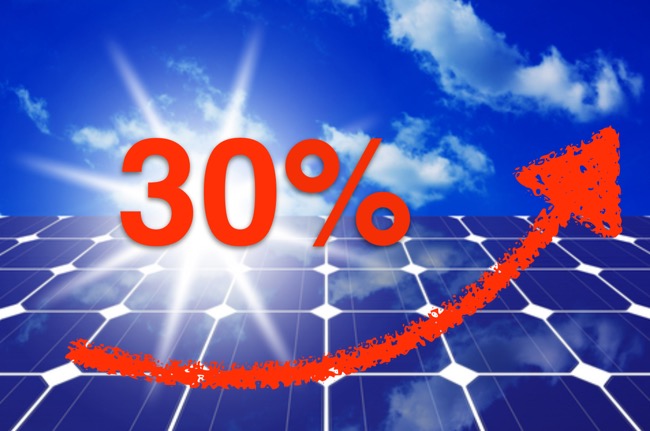
30% solar cell efficiency is on the way. That would mean a 50% reduction in the cost of solar. Hooray!
Will 2016 see the beginning of the end for fossil fuels in the wake of the rise and rise of green energy? Many commentators are saying this is the case and if solar cell efficiency gains are any indication, they have a good case.
Already SolarQuotes has reported on the strides made by Trina solar panels. With the company’s R&D department apparently cranked up to 11, the leading Chinese company last month announced they had achieved an efficiency of 22.13 percent for a 156 x 156mm² mono-crystalline silicon (c-Si) solar cell.
This just months after notching up a new record for p-type polycrystalline silicon solar cell efficiency.
Now just one week into the New Year comes reports of another major breakthrough. As reported in science journal Phys Org, a team of researchers at the Energy Department’s National Renewable Energy Laboratory (NREL) and the Swiss Centre for Electronics and Microtechnology (CSEM) have struck (photovoltaic) gold.
For the team have achieved solar cell efficiencies of 29.8 percent for conversion of sunlight into electricity using a dual-junction III-V/Si solar cell. The revolutionary cell consists of a “…top cell made of gallium indium phosphide developed by NREL, and a bottom cell made of crystalline silicon developed by CSEM using silicon heterojunction technology,” according to a Jan 5 NREL media release.
“It’s a record within this mechanically stacked category,” said David Young, a senior researcher at NREL (helpfully). “The performance of the dual-junction device exceeded the theoretical limit of 29.4 percent for crystalline silicon solar cells.”
Specifically the dual junction cell was a combination of the two technologies which were developed separately at the two research centres and then stacked at NREL.
Like Roger Bannister’s four minute mile, the team believe they are on the verge of smashing a psychological barrier: the 30 percent solar cell efficiency gains. As Matthieu Despeisse, the manager of crystalline silicon activities at CSEM, put it quite elegantly.
“CSEM partnered with the NREL scientists with the objective to demonstrate that 30 percent efficient tandem cells can be realized using silicon heterojunction bottom cells, thanks to the combination with high performance top cells such as those developed by NREL,” he said.
While it almost inevitable that the 30 percent barrier will be achieved, how far will researchers around the world go in improving solar cell efficiency gains in 2016? Maybe, as the Toronto Star claims, this will be the year of green energy, driven by even more efficiency breakthroughs? Your thoughts please.

 RSS - Posts
RSS - Posts



Thanks Rich. Whilst these recent breakthroughs are good news indeed, it all begs a serious question as to how long it will take to turn these achievements into final products and how much they will cost. I assume that the double layered device revealed here would prove to be expensive relative to the price of current platforms.
Hi Rich, What tends to be the lag time in getting these types of new developments into production. And for the more “prosaic” advances made by Trina, how long, generally speaking, before that technology is incorporated into their panels ?
We have been hearing about great leaps in PV efficiency in lab settings but gains in commercially available cells seem delayed and modest. Hopefully these efficiency gains will become available quickly and continue to help drive down the cost of modules.
Rich, 30% is an awesome goal and it’s fantastic that researchers are so close to reaching it. Back here on the ground, it’s the cost/kWh that really matters. Super high efficiency panels are great for buildings with limited roof space but, unless they’re cheaper per kWh they don’t offer a lot of practical help to those of us trying to build energy positive houses at an affordable price. Cheers, Andy.
Arnt you getting clients hopes and expectations too high.i will be years before i can install 30% efficient panels on my house